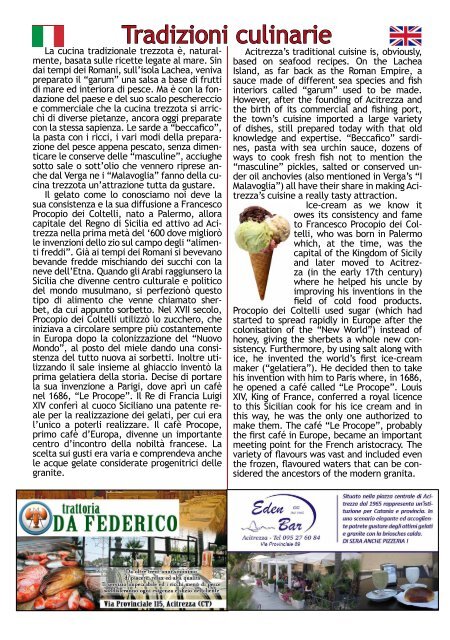Guida turistica Aci Trezza 2013 - Xiphonia Coop. a rl - Turismo ad ...
Guida turistica Aci Trezza 2013 - Xiphonia Coop. a rl - Turismo ad ...
Guida turistica Aci Trezza 2013 - Xiphonia Coop. a rl - Turismo ad ...
You also want an ePaper? Increase the reach of your titles
YUMPU automatically turns print PDFs into web optimized ePapers that Google loves.
Tr<strong>ad</strong>izioni culinarie<br />
La cucina tr<strong>ad</strong>izionale trezzota è, naturalmente,<br />
basata sulle ricette legate al mare. Sin<br />
dai tempi dei Romani, sull’isola Lachea, veniva<br />
preparato il “garum” una salsa a base di frutti<br />
di mare ed interiora di pesce. Ma è con la fondazione<br />
del paese e del suo scalo peschereccio<br />
e commerciale che la cucina trezzota si arricchì<br />
di diverse pietanze, ancora oggi preparate<br />
con la stessa sapienza. Le sarde a “beccafico”,<br />
la pasta con i ricci, i vari modi della preparazione<br />
del pesce appena pescato, senza dimenticare<br />
le conserve delle “masculine”, acciughe<br />
sotto sale o sott’olio che vennero riprese anche<br />
dal Verga ne i “Malavoglia” fanno della cucina<br />
trezzota un’attrazione tutta da gustare.<br />
Il gelato come lo conosciamo noi deve la<br />
sua consistenza e la sua diffusione a Francesco<br />
Procopio dei Coltelli, nato a Palermo, allora<br />
capitale del Regno di Sicilia ed attivo <strong>ad</strong> <strong>Aci</strong>trezza<br />
nella prima metà del ‘600 dove migliorò<br />
le invenzioni dello zio sul campo degli “alimenti<br />
freddi”. Già ai tempi dei Romani si bevevano<br />
bevande fredde mischiando dei succhi con la<br />
neve dell’Etna. Quando gli Arabi raggiunsero la<br />
Sicilia che divenne centro culturale e politico<br />
del mondo musulmano, si perfezionò questo<br />
tipo di alimento che venne chiamato sherbet,<br />
da cui appunto sorbetto. Nel XVII secolo,<br />
Procopio dei Coltelli utilizzò lo zucchero, che<br />
iniziava a circolare sempre più costantemente<br />
in Europa dopo la colonizzazione del “Nuovo<br />
Mondo”, al posto del miele dando una consistenza<br />
del tutto nuova ai sorbetti. Inoltre utilizzando<br />
il sale insieme al ghiaccio inventò la<br />
prima gelatiera della storia. Decise di portare<br />
la sua invenzione a Parigi, dove aprì un cafè<br />
nel 1686, “Le Procope”. Il Re di Francia Luigi<br />
XIV conferì al cuoco Siciliano una patente reale<br />
per la realizzazione dei gelati, per cui era<br />
l’unico a pote<strong>rl</strong>i realizzare. Il cafè Procope,<br />
primo cafè d’Europa, divenne un importante<br />
centro d’incontro della nobiltà francese. La<br />
scelta sui gusti era varia e comprendeva anche<br />
le acque gelate considerate progenitrici delle<br />
granite.<br />
<strong>Aci</strong>trezza’s tr<strong>ad</strong>itional cuisine is, obviously,<br />
based on seafood recipes. On the Lachea<br />
Island, as far back as the Roman Empire, a<br />
sauce m<strong>ad</strong>e of different sea species and fish<br />
interiors called “garum” used to be m<strong>ad</strong>e.<br />
However, after the founding of <strong>Aci</strong>trezza and<br />
the birth of its commercial and fishing port,<br />
the town’s cuisine imported a large variety<br />
of dishes, still prepared today with that old<br />
knowledge and expertise. “Beccafico” sardines,<br />
pasta with sea urchin sauce, dozens of<br />
ways to cook fresh fish not to mention the<br />
“masculine” pickles, salted or conserved under<br />
oil anchovies (also mentioned in Verga’s “I<br />
Malavoglia”) all have their share in making <strong>Aci</strong>trezza’s<br />
cuisine a really tasty attraction.<br />
Ice-cream as we know it<br />
owes its consistency and fame<br />
to Francesco Procopio dei Coltelli,<br />
who was born in Palermo<br />
which, at the time, was the<br />
capital of the Kingdom of Sicily<br />
and later moved to <strong>Aci</strong>trezza<br />
(in the ea<strong>rl</strong>y 17th century)<br />
where he helped his uncle by<br />
improving his inventions in the<br />
field of cold food products.<br />
Procopio dei Coltelli used sugar (which h<strong>ad</strong><br />
started to spre<strong>ad</strong> rapidly in Europe after the<br />
colonisation of the “New Wo<strong>rl</strong>d”) inste<strong>ad</strong> of<br />
honey, giving the sherbets a whole new consistency.<br />
Furthermore, by using salt along with<br />
ice, he invented the wo<strong>rl</strong>d’s first ice-cream<br />
maker (“gelatiera”). He decided then to take<br />
his invention with him to Paris where, in 1686,<br />
he opened a café called “Le Procope”. Louis<br />
XIV, King of France, conferred a royal licence<br />
to this Sicilian cook for his ice cream and in<br />
this way, he was the only one authorized to<br />
make them. The café “Le Procope”, probably<br />
the first café in Europe, became an important<br />
meeting point for the French aristocracy. The<br />
variety of flavours was vast and included even<br />
the frozen, flavoured waters that can be considered<br />
the ancestors of the modern granita.


